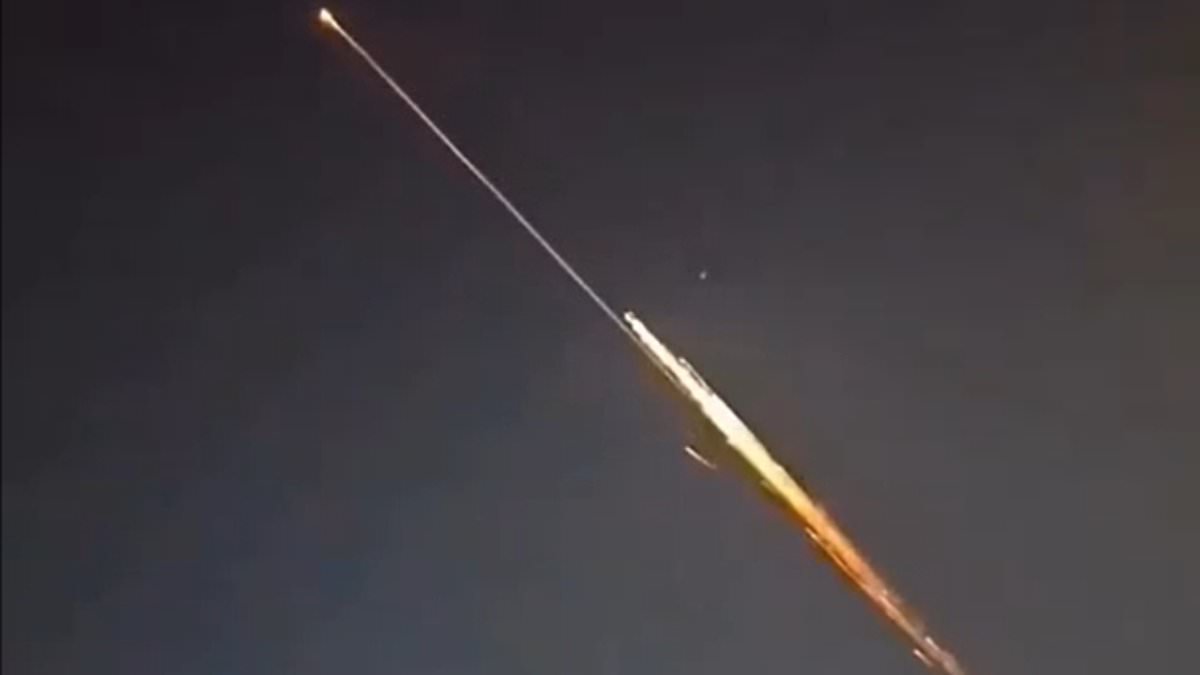Mysterious objects were spotted falling from the sky and breaking apart over several states, leaving thousands baffled by the cosmic display.
Streaks of glowing lights appeared over parts of Colorado, Texas, Oklahoma and Kansas, leaving people questioned were a possible fireball or part of a series of meteor showers.
Dozens of people reported the phenomenon at about 9pm ET, saying the lights streaked through the sky for up to 60 seconds before disappearing.
Witnesses captured the show, revealing what appeared to be a red and orange meteor shower shining bright as it broke up into several parts before it slowly dimmed and disappeared from the night sky.
A Texas resident reported that it ‘first seemed like it was going straight up toward the sky then went directly over our head and we could see it breaking up as it traveled directly over us.’
Another person in the Lone Star State described it as ‘by far the brightest meteor event I have ever witnessed.’
However, astronomer and orbital debris expert Jonathan McDowell confirmed the light show was caused by a SpaceX Starlink satellite breaking up as it re-entered Earth’s atmosphere.

A Starlink satellite set off a fiery display as it re-entered the Earth’s atmosphere on Saturday night

People across Oklahoma, Colorado, Kansas and Texas speculated whether the lights in the night sky (pictured) were caused by fireworks
SpaceX has thousands of its Starlink satellites orbiting Earth to provide internet access to remote areas around the world, launching 98 this year as of mid-October.
At the end of their mission, internet satellites are designed to re-enter the atmosphere to avoid cluttering Earth’s orbit with space debris.
McDowell told Space.com that these satellites ‘are dominating’ the clutter in Earth’s atmosphere, adding that ‘there is now a Starlink reentry almost every day, sometimes multiple.’
The satellite re-entered over Washington state and continued southeast before disappearing over northern Texas.
An Oklahoma resident described the satellite as a ‘bright fire ball heading southeast, slow moving, looked like it split into 3 parts,’ while another called it ‘the coolest thing I’ve seen.’
Some people speculated that the satellite was part of a series of three meteor showers – the Leonids and Southern and Northern Taurids – that reached peak activity this month.
The number of Starlink satellites that have reentered the atmosphere has drastically increased over the last fiver years, jumping from between 50 and 100 per year to around 300 annually.
‘We are seeing a similar increase in the number of satellites now that hundreds of Starlink satellites are starting to come down,’ McDowell told Space.com.

The satellite entered over Washington state and flew southeast across the US before fizzling out over northern Texas

Researchers have found that burning up satellites in the atmosphere could destroy the ozone. Pictured: Starlink satellite burning up as it re-enters Earth’s atmosphere
Although satellites burning up as they re-enter the atmosphere has become standard practice, researchers have questioned whether the metal particles could destroy the ozone over time.
This is because the satellites are so large and burn up slowly, releasing aerosol particles that are less than one micrometer in size.
A 2023 study found that satellite re-entries have already begun to change the stratosphere’s composition.
A NASA WB-57 aircraft found 500,000 single aerosol particles that contained 20 different elements including lithium, aluminum, copper and lead.
Out of all the elements found, aluminum was the most concerning because it could react with the hydrogen chloride – a pre-existing component in the stratosphere – causing it to split apart and destroy the ozone.
Pierre Lionnet, the managing director of ASD Eurospace, a space industry trade association told Science.org that the number of satellites returning to Earth does matter.
SpaceX accounts for more than 6,000 satellites in orbit and the company has already applied to the Federal Communications Commission (FCC) for permission to launch another 30,000 in low orbit.
Because of the mass volume of Starlink satellites, Lionnet said: ‘You have to wonder whether [SpaceX] is creating a major problem 30 years from now.’
